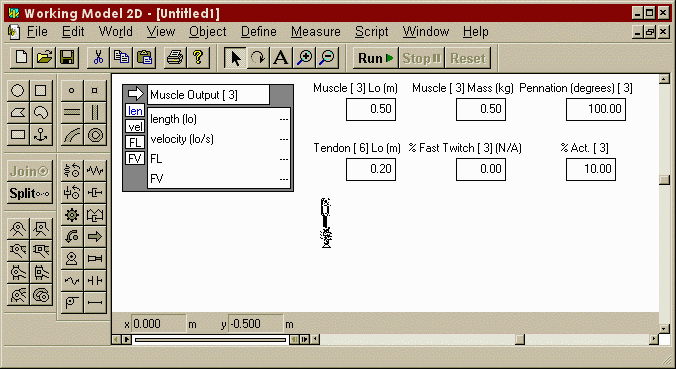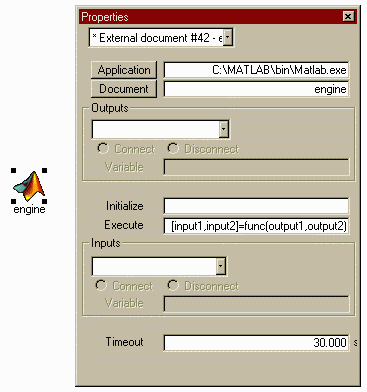 |
The basis for our design (first implemented in a preliminary version in Loeb et al., submitted) is the software package Working Model 2D (in Italy, offered by Lista Studio srl). This motion simulation package contains a scripting language and the capability to communicate with other software packages such as Matlab. We wrote a generic script that allows us to create a single musculotendon unit with as many scalable parameters as possible. The musculotendon unit created includes a tendon, fascicle and muscle mass. Currently, we are limited to simulating slow-twitch muscle properties, pending the completion of ongoing experiments on fast-twitch muscle (feline Caudofemoralis). In the future, we will include capabilities in this script to simulate heterogeneous muscles composed of both slow- and fast-twitch fibers.
Where possible, mechanical parameters of our musculotendon unit have been defined by a few measureable constants such as optimal fascicle length (L0), pennation angle and muscle mass. These parameters are then associated with equations to other physiological constants such as optimal muscle force (F0) through intermediate constants (such as specific tension). All parameters can be redefined by the user at any time. This setup allows the musculotendon unit to be modified easily for various muscles of different architectures. The methods for changing constants in the script are described later in this document.
The current version of the script may be downloaded by right-clicking on the link below and choosing Save Link As or Save Link, depending on the browser you are using. Save the script into your working Working Model directory.
(Note: if you download this script and use it, please email us [loeb@biomed.queensu.ca] so that we can create a database of users).
If you are already familiar with the use of Working Model and its scripting language, you can open Working Model, create a new document, and run the script to insert the musculotendon elements. The script can be run multiple times to create multiple musculotendon elements in a single Working Model document. If you are not familiar with Working Model, instructions on using and modifying the musculotendon element are listed below. Note that this script only works with Working Model 2D, and not Working Model 3D, as the latter version has no scripting capabilities.
 |
The constants for the various muscle equations were based upon work on feline soleus, an exclusively slow-twitch muscle (Brown et al., 1996), and are listed in lines 21-46 of the MAKEMUSC.WBS file. The default values correspond to those in Table A1 of Loeb et al (submitted). This file can be edited by a text editor such as Notepad or with the built-in Script Editor from Working Model 2D. For details on how to access the Script Editor, click here. The muscle density (Mendez and Keyes, 1960) and specific tension (Scott et al., 1996; Brown et al., submitted) constants can be modified by changing the values in lines 48-50.
If, for some reason, the form of the equations describing the muscle and tendon properties need to be altered, these equations are listed in lines 128-148. Working Model 2D v4.01 script editor has a limitation in that at most 255 characters can be input per row; thus parts of certain lengthy equations had to be split into a temp variable and then appended to the actual desired formula.
 |
[input1,input2,input3,...,inputx]=matlab_function_name(output1,output2,output3,...,outputx)
Click here for a more detailed explanation on the use of this function.
Brown, I.E., Satoda, T, Richmond, F.J.R., Loeb, G.E. (Submitted) Feline caudofemoralis muscle: muscle fiber properties, architecture and motor innervation.
Loeb, G.E., Brown, I.E., and Cheng. E.J. (Submitted) A Heirarchical Foundation for Models of Sensorimotor Control.
Mendez, J. and Keys, A. (1960) Density and composition of mammalian muscle. Metabolism, 9: 69-78.
Zajac, F.E. (1989) Muscle and tendon: Properties, models, scaling and application to biomechanics and motor control. Crit.Rev.Biomed.Engng. 17:359-411.